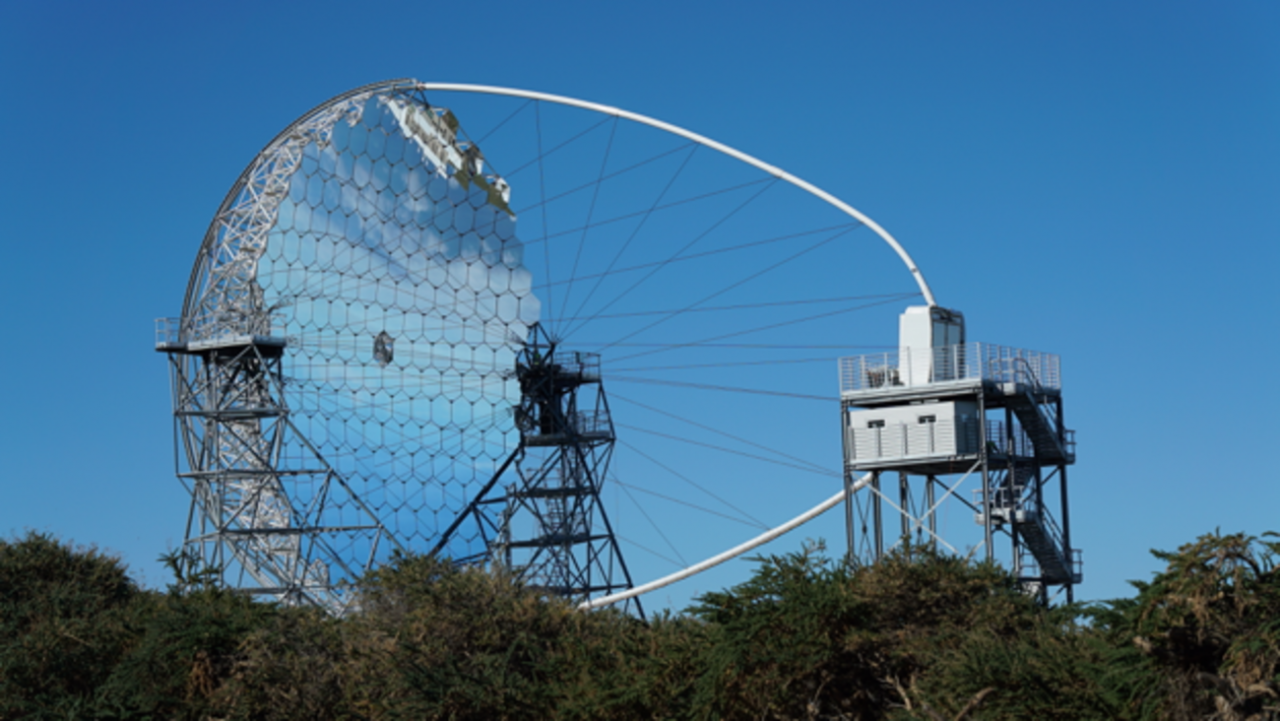Subvenciones relacionadas:
General
El Grupo de Astrofísica de Partículas del IAC participa activamente en tres grandes colaboraciones internacionales de astrofísica de muy altas energías: AMS (Alpha Magnetic Spectrometer), los telescopios de radiación Cherenkov MAGIC I y II, y el Cherenkov Telescope Array (CTA).
AMS es un detector de partículas diseñado para operar en el espacio, a bordo de la Estación Espacial Internacional. Se instaló con éxito en mayo de 2011, y se espera que opere durante toda la vida útil de la misma. Su misión es realizar un estudio de alta precisión y estadística del espectro y la composición de los rayos cósmicos primarios en un amplio rango de energía, así como buscar antimateria primordial y materia oscura de forma indirecta.
La colaboración MAGIC está formada por 20 institutos y departamentos universitarios de Alemania, Armenia, Bulgaria, España, EEUU, Finlandia, Italia, Polonia y Suiza. La colaboración cuenta con dos telescopios de 17 m de diámetro localizados en el Obsevatorio del Roque de los Muchachos, diseñados para medir la radiación Cherenkov asociada a cascadas atmosféricas producidas por rayos gamma de muy alta energía y localizados en el Observatorio del Roque de los Muchachos.
Además de esto, y también en el marco de la observación de rayos gamma de muy alta energia, el IAC participa en la colaboración internacional CTA, cuyo objetivo es construir dos grandes complejos de observación en los hemisferios Norte y Sur. El Observatorio del Roque de los Muchachos, en La Palma, ha sido seleccionado para albergar el observatorio Norte. El primer telescopio de gran diámetro fue inaugurado en octubre de 2018 y actualmente estamos en la fase de construcción de otros tres.
Miembros
Resultados
- Inauguración del primer telescopio de gran diámetro (LST-1) de la red de telescopios Cherenkov (CTA) en el Observatorio del Roque de los Muchachos
- Detección de la procedencia de un neutrino originado en un "blazar" por parte de MAGIC, IceCube y Fermi-LAT
- Descubrimiento de la nueva binaria de rayos gamma de muy alta energía PSR J2032+4127/MT91 213
Actividad científica
Publicaciones relacionadas
-
Discovery of a Very High Energy Gamma-Ray Signal from the 3C 66A/B Region
The MAGIC telescope observed the region around the distant blazar 3C 66A for 54.2 hr in 2007 August-December. The observations resulted in the discovery of a γ-ray source centered at celestial coordinates R.A. = 2h23m12s and decl. = 43°0farcm7 (MAGIC J0223+430), coinciding with the nearby radio galaxy 3C 66B. A possible association of the excess
Aliu, E. et al.Fecha de publicación:
22009 -
Detection of Very High Energy γ-ray Emission from the Perseus Cluster Head-Tail Galaxy IC 310 by the MAGIC Telescopes
We report on the detection with the MAGIC telescopes of very high energy (VHE) γ-rays from IC 310, a head-tail radio galaxy in the Perseus galaxy cluster, observed during the interval 2008 November to 2010 February. The Fermi satellite has also detected this galaxy. The source is detected by MAGIC at a high statistical significance of 7.6σ in 20.6
Aleksić, J. et al.Fecha de publicación:
112010 -
Correlated X-Ray and Very High Energy Emission in the Gamma-Ray Binary LS I +61 303
The discovery of very high energy (VHE) gamma-ray emitting X-ray binaries has triggered an intense effort to better understand the particle acceleration, absorption, and emission mechanisms in compact binary systems, which provide variable conditions along eccentric orbits. Despite this, the nature of some of these systems, and of the accelerated
Anderhub, H. et al.Fecha de publicación:
112009 -
Performance of the MAGIC stereo system obtained with Crab Nebula data
MAGIC is a system of two Imaging Atmospheric Cherenkov Telescopes located in the Canary island of La Palma. Since autumn 2009 both telescopes have been working together in stereoscopic mode, providing a significant improvement with respect to the previous single-telescope observations. We use observations of the Crab Nebula taken at low zenith
Aleksić, J. et al.Fecha de publicación:
22012 -
Detection of the γ-Ray Binary LS I +61°303 in a Low-flux State at Very High Energy γ-Rays with the MAGIC Telescopes in 2009
We present very high energy (E > 100 GeV) γ-ray observations of the γ-ray binary system LS I +61°303 obtained with the MAGIC stereo system between 2009 October and 2010 January. We detect a 6.3σ γ-ray signal above 400 GeV in the combined data set. The integral flux above an energy of 300 GeV is F(E > 300 GeV) = (1.4 ± 0.3stat ± 0.4syst) × 10-12 cm
Aleksić, J. et al.Fecha de publicación:
22012 -
The 2010 Very High Energy γ-Ray Flare and 10 Years of Multi-wavelength Observations of M 87
The giant radio galaxy M 87 with its proximity (16 Mpc), famous jet, and very massive black hole ((3 - 6) × 109 M &sun;) provides a unique opportunity to investigate the origin of very high energy (VHE; E > 100 GeV) γ-ray emission generated in relativistic outflows and the surroundings of supermassive black holes. M 87 has been established as a VHE
Abramowski, A. et al.Fecha de publicación:
22012 -
Phase-resolved energy spectra of the Crab pulsar in the range of 50-400 GeV measured with the MAGIC telescopes
We use 73 h of stereoscopic data taken with the MAGIC telescopes to investigate the very high-energy (VHE) gamma-ray emission of the Crab pulsar. Our data show a highly significant pulsed signal in the energy range from 50 to 400 GeV in both the main pulse (P1) and the interpulse (P2) phase regions. We provide the widest spectra to date of the VHE
Aleksić, J. et al.Fecha de publicación:
42012 -
PG 1553+113: Five Years of Observations with MAGIC
We present the results of five years (2005-2009) of MAGIC observations of the BL Lac object PG 1553+113 at very high energies (VHEs; E > 100 GeV). Power-law fits of the individual years are compatible with a steady mean photon index Γ = 4.27 ± 0.14. In the last three years of data, the flux level above 150 GeV shows a clear variability (probability
Aleksić, J. et al.Fecha de publicación:
32012 -
Mrk 421 active state in 2008: the MAGIC view, simultaneous multi-wavelength observations and SSC model constrained
Context. The blazar Markarian 421 is one of the brightest TeV gamma-ray sources of the northern sky. From December 2007 until June 2008 it was intensively observed in the very high energy (VHE, E > 100 GeV) band by the single-dish Major Atmospheric Gamma-ray Imaging Cherenkov telescope (MAGIC-I). Aims: We aimed to measure the physical parameters of
Aleksić, J. et al.Fecha de publicación:
62012 -
Morphological and spectral properties of the W51 region measured with the MAGIC telescopes
Context. The W51 complex hosts the supernova remnant W51C which is known to interact with the molecular clouds in the star forming region W51B. In addition, a possible pulsar wind nebula CXO J192318.5+140305 was found likely associated with the supernova remnant. Gamma-ray emission from this region was discovered by Fermi/LAT (between 0.2 and 50
Aleksić, J. et al.Fecha de publicación:
52012 -
MAGIC observations of the giant radio galaxy M 87 in a low-emission state between 2005 and 2007
Context. We present the results of a long M 87 monitoring campaign in very high energy γ-rays with the MAGIC-I Cherenkov telescope. Aims: We aim to model the persistent non-thermal jet emission by monitoring and characterizing the very high energy γ-ray emission of M 87 during a low state. Methods: A total of 150 h of data were taken between 2005
Aleksić, J. et al.Fecha de publicación:
82012 -
High zenith angle observations of PKS 2155-304 with the MAGIC-I telescope
Context. The high frequency peaked BL Lac PKS 2155-304 with a redshift of z = 0.116 was discovered in 1997 in the very high energy (VHE, E > 100 GeV) γ-ray range by the University of Durham Mark VI γ-ray Cherenkov telescope in Australia with a flux corresponding to 20% of the Crab Nebula flux. It was later observed and detected with high
Aleksić, J. et al.Fecha de publicación:
82012 -
Discovery of VHE γ-rays from the blazar 1ES 1215+303 with the MAGIC telescopes and simultaneous multi-wavelength observations
Context. We present the discovery of very high energy (VHE, E > 100 GeV) γ-ray emission from the BL Lac object 1ES 1215+303 by the MAGIC telescopes and simultaneous multi-wavelength data in a broad energy range from radio to γ-rays. Aims: We study the VHE γ-ray emission from 1ES 1215+303 and its relation to the emissions in other wavelengths
Aleksić, J. et al.Fecha de publicación:
82012 -
Discovery of VHE γ-ray emission from the BL Lacertae object B3 2247+381 with the MAGIC telescopes
Aims: We study the non-thermal jet emission of the BL Lac object B3 2247+381 during a high optical state. Methods: The MAGIC telescopes observed the source during 13 nights between September 30th and October 30th 2010, collecting a total of 14.2 h of good quality very high energy (VHE) γ-ray data. Simultaneous multiwavelength data was obtained with
Aleksić, J. et al.Fecha de publicación:
32012 -
Detection of VHE γ-Rays from HESS J0632+057 during the 2011 February X-Ray Outburst with the MAGIC Telescopes
The very high energy (VHE) γ-ray source HESS J0632+057 has recently been confirmed to be a γ-ray binary. The optical counterpart is the Be star MWC 148, and a compact object of unknown nature orbits it every ~321 days with a high eccentricity of ~0.8. We monitored HESS J0632+057 with the stereoscopic MAGIC telescopes from 2010 October to 2011 March
Aleksić, J. et al.Fecha de publicación:
72012 -
Detection of very-high energy γ-ray emission from NGC 1275 by the MAGIC telescopes
We report on the detection of very-high energy (VHE, E > 100 GeV) γ-ray emission from NGC 1275, the central radio galaxy of the Perseus cluster of galaxies. The source has been detected by the MAGIC telescopes with a statistical significance of 6.6σ above 100 GeV in 46 h of stereo observations carried out between August 2010 and February 2011. The
Aleksić, J. et al.Fecha de publicación:
32012 -
Constraining cosmic rays and magnetic fields in the Perseus galaxy cluster with TeV observations by the MAGIC telescopes
Galaxy clusters are being assembled today in the most energetic phase of hierarchical structure formation which manifests itself in powerful shocks that contribute to a substantial energy density of cosmic rays (CRs). Hence, clusters are expected to be luminous gamma-ray emitters since they also act as energy reservoirs for additional CR sources
Aleksić, J. et al.Fecha de publicación:
52012



